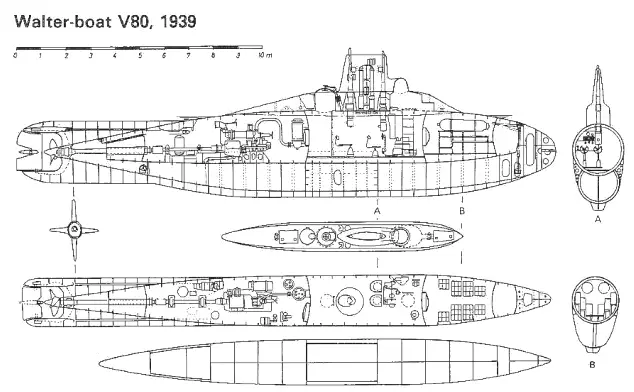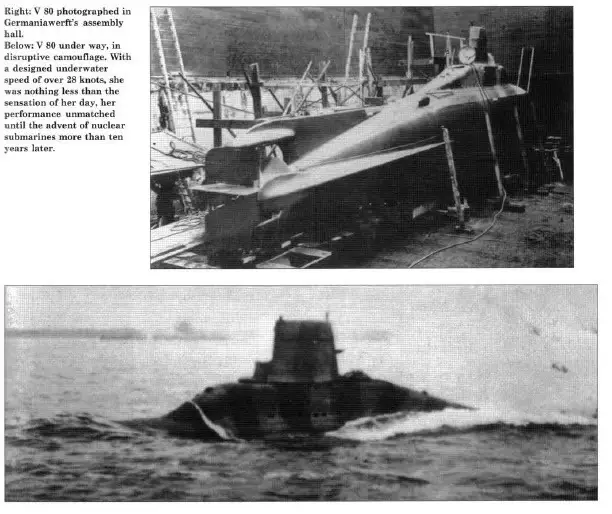Long before the United States experimented with a tuna-shaped submarine, the Germans did. The V80 was an experimental, unarmed research sub (and therefore a perfect analog of Albacore) that was intended to test new technology in propulsion and hydrodynamics. First underway in 1939, it was never commissioned into the Deutsche Kriegsmarine, formally, but it was intended to show the way forward in submarine technology.
Indeed it did — but not in time to benefit the Germans.
The two revolutionary technologies in the V80 were air-independent propulsion and improved hydrodynamics, from using a streamlined, tuna-like shape. In addition to the attempt to lower the form drag on the vessel, great attention was paid to eliminating all the usual parasitic producers of turbulence on then-current boats: handrails, drain holes, rivets and plates and bulges. In addition to the main benefit, speed, the V80 demonstrated that a cleanup of the sub’s shape and skin could greatly reduce its sonar signature.
Its name came from Versuchs (test) and its displacement, 80 tons. It had bunkerage for 21 tons of concentrated (“High Test”) H2O2 which gave it a range of only 50 nautical miles at its ultimate top speed of 28 knots. It carried a crew of 4 and no arms at all.
The AIP installation used in the V80 was a hydrogen peroxide catalytic turbine. The engine, and the sub, were designed by rocket-engine and H2O2 expert Dr. Ing. Hellmuth Walter, whose fertile mind and sharp pencil also provided the rockets that drove the Me163 fighter jet and that were used as JATO boosters by German aircraft.
In the engine, the peroxide was exposed to a catalyst and produced an exothermic reaction that drove the turbine with the output gases: oxygen and steam (water vapor). With the efficient (for the day) engine and the sub’s special shape, the V80 set speed records — 23 knots in 1939.
Admiral Karl Dönitz immediately grasped the potential of this technology, and Walter went to work designing larger boats. There was, first, a double class of weaponized research vessels, the Type XVIIA and XVIIB boats. Then there was the Type XVIII. None of these was made in quantity, or in time, to have a combat impact.
After the war, these technologies were pursued for a while, but they had safety implications that ultimately sidelined them, especially after the advent of nuclear power. The Russians use peroxide propulsion for some torpedoes (which caused the loss of the submarine Kursk and its crew), and in recent years, air-independent propulsion has made a comeback.
Sources:
Uboat.net. U-boat Types: The Walter Boats: The Walter U-boat Types. Retrieved from: http://uboat.net/types/walter.htm
Uboat.net. U-boat Types: The Walter Boats: V80. Retrieved from: http://uboat.net/types/v80.htm

Kevin was a former Special Forces weapons man (MOS 18B, before the 18 series, 11B with Skill Qualification Indicator of S). His focus was on weapons: their history, effects and employment. He started WeaponsMan.com in 2011 and operated it until he passed away in 2017. His work is being preserved here at the request of his family.



11 thoughts on “Before the USS Albacore, there was the V80”
Just taking all the claptrap off the deck of those old boats did wonders for them in terms of speed and quietness. However, they obviously did the job with what they had.
“exothermic reaction that drove the turbine with the output gases: ”
Forget sonar, just follow the bubbles.
If the Germans had the subs Adam. Donitz required at the start of the war, it would have been an entirely new war and one not favorable to the Allies. The same goes in the early Pacific War with the poor US sub equipment and tactics. Hindsight is wonderful of course but I do wonder if the Chinese are paying attention?
Happy New Year. I’m off to the beach in sunny Perth.
Loren, IIRC it was a closed cycle system. No bubbles.
Regarding the safety issues, the Walter submarine engines used the same T-Stoff propellant as the Me 163 Komet which had to be flown wearing a rubber hazmat suit, to keep fuel leaks from dissolving the pilot. At the 80-90% concentration used for propulsion, hydrogen peroxide is worlds away from the 5-10% concentration used as antiseptic or hair bleach, although it can get even nastier if you jam a third oxygen atom in there to make HOOOH.
The Me163a used a catalyst engine. It was an unarmed research plane. They experimented with platinum and silver for the catalyst, I believe they settled on silver.
H202 -(Ag)—> H2 + O2
Very environmentally friendly, but Helmut Walter and his guys knew they were leaving thrust on that table and developed the two-stage engine which scavenged the H2 from the first stage exhaust by injecting hydrazine hydrate (N2H4) roughly doubling thrust (and answering the question of how do you maintain performance when you double the aircraft weight with combat radios, armor, and 2x 30mm cannon).
Hydrazine is mind-bogglingly hazardous stuff, although not quite out there in instability land with unstable peroxides (HOOOH) or my favorite chemical symbol, FOOF.
The fellow who taught me to fly (in gliders) was a test pilot in the Me163 program (Rudy also flew the first test flight of the Me110). He didn’t normally talk about it, but he did say it wasn’t much fun to fly under power. He flew as a test pilot (for P & W) into his 90’s – I have no idea how he got the FAA to go along with that.
I was believe that when hydrogen peroxide used as a rocket monopropellant decomposes, it forms water and oxygen, not hydrogen and oxygen.
That’s right. H2O (steam, actually) and O. The extra O can be combusted with another fuel. Walter patented that idea in 1925.
Erq. You’re right. Water vapor (steam) and oxygen. Environmentally friendly. Cripes, the equation I posted doesn’t even add up.
The photo surface running reminds me of a great movie,20000Leagues Under The Sea,the classic version with Mason/Douglas ect.a great classic book and film.
It does, I was posting the item and wondering if the production designers who made Captain Nemo’s steampunk-before-steampunk-was-a-thing Nautilus had seen pictures of the V80.